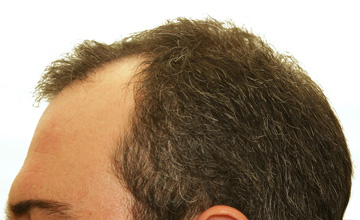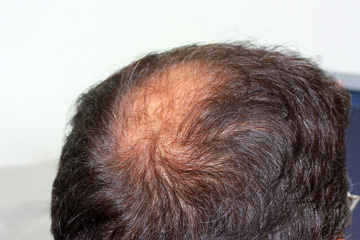Hair Loss In Men
Some men gradually lose their hair over the front, top, and crown of their head, but most men still do not understand the root cause of hair loss. This is a natural phenomenon called “male pattern baldness” or androgenetic alopecia. “Andro” refers to the androgens (testosterone, dihydrotestosterone) necessary to produce male-pattern hair loss (MPHL). “Genetic” refers to the inherited gene necessary for MPHL to occur.”
The hair follicles in these areas react negatively to the hormone testosterone, resulting in gradual hair loss. The hair on the sides and lower back of the head is genetically programmed not to be affected and does not fall out. Because of this genetic programming, this hair can be permanently transplanted by a NuHart hair transplant physician to the thinning and balding areas. This donor hair will not fall out and can be cut, combed, and styled just as the hair it has replaced. It will continue to grow for the rest of your life and will not be affected by any hormone changes.

Scale of Male Pattern Baldness
- represents a normal head of hair with no visible hair loss.
- is characterized by the beginning of a receding hairline and a “widow’s peak” on the forehead.
- patients exhibit a more significant decline in hair above the temples as well as receding from the forehead. In Class 3 Vertex, hair loss is starting to become significant on the crown.
- hair loss may become more noticeable on the crown or patients may have significant hair loss above the temples and/or front anterior areas.
- hair loss approaches significant levels with most hair loss occurring on the top of the vertex and crown. Hair transplantation for this Class and higher Class levels may require more grafts to provide coverage and density.
- patients show major hair loss, but still have areas with donor hair available. Transplanting this hair can still have excellent results.
- patients show the most significant loss of hair. There may still be sufficient donor hair for transplantation; however, results may be limited.
It is estimated that 35 million men in the United States are affected by male pattern baldness. In men who develop male pattern baldness the hair loss may begin any time after puberty when blood levels of androgens rise. The first change is usually recession in the temporal areas, which is seen in 96 percent of mature Caucasian males, including those men not destined to progress to further hair loss.
Hair loss in men is likely to occur primarily between late teen-age years and age 40-50, in a generally recognizable “male-pattern” baldness known as androgenetic alopecia. Men with male-pattern hair loss may have an expectation of hair loss if they have male relatives who lost hair in a recognizably male pattern. Although the density of hair in a given pattern of loss tends to diminish with age, there is no way to predict what pattern of hair loss a young man with early male pattern baldness will eventually assume. In general, those who begin losing hair in the second decade are those in whom the hair loss will be the most severe. In some men, initial male-pattern hair loss may be delayed until the late third to fourth decade. It is generally recognized that men in their 20s have a 20 percent incidence of male pattern baldness, in their 30s a 30 percent incidence of male pattern baldness, in their 40s a 40 percent incidence of male pattern baldness, etc. Using these numbers one can see that a male in his 90s has a 90 percent chance of having some degree of male pattern baldness. The onset, rate, and severity of hair loss are unpredictable. The severity increases with age and if the condition is present it will be progressive and relentless.
The amount of androgens present does not need to be greater than normal for male pattern baldness to occur. If androgens are present in normal amounts and the gene for hair loss is present, male pattern hair loss will occur. Axillary (under arm) and pubic hair are dependent on testosterone for growth. Beard growth and male pattern hair loss are dependent on dihydrotestosterone (DHT). Testosterone is converted to DHT by the enzyme, 5 -reductase. Receptors exist on cells that bind androgens. These receptors have the greatest affinity for DHT followed by testosterone, estrogen, and progesterone. After binding to the receptor, DHT goes into the cell and interacts with the nucleus of the cell altering the production of protein by the DNA in the nucleus of the cell. Ultimately growth of the hair follicle ceases.

The hair growth cycle is affected in that the percentage of hairs in the growth phase (anagen) and the duration of the growth phase diminish resulting in shorter hairs. More hairs are in the resting state (telogen) and these hairs are much more subject to loss with the daily trauma of combing and washing.
Hair Loss in Men
The hair shafts in male pattern baldness become progressively miniaturized, smaller in diameter and length, with time. In men with male pattern baldness all the hairs in an affected area may eventually (but not necessarily) become involved in the process and may with time cover the region with fine (vellus) hair.

Pigment (color) production is also terminated with miniaturization so the fine hair becomes lighter in color. The lighter color, miniaturized hairs cause the area to first appear thin. Involved areas in men can completely lose all follicles over time. Male pattern baldness is an inherited condition and the gene can be inherited from either the mother or father’s side. There is a common myth that inheritance is only from the mother’s side. This is not true.
In summary, male pattern hair loss (Androgenetic Alopecia) is an inherited condition manifested when androgens are present in normal amounts. The gene can be inherited from the mother or father’s side. Medical science has come to learn that baldness genes are actually passed down from both sides of the family—and they affect hair loss in women as well as men. Baldness genes may also skip generations and are utterly random in terms of which siblings (male or female) they will affect. They may even have very different effects on siblings in the same family. NuHart Specializes in state-of-the-art hair restoration procedures.
Concerned About Your Hair Loss Troubles?
Set aside those worries, for now, we at NU/HART Philippines are more than happy to help you deal with this problem. All you have to do is send your inquiries to: info@nuhartclinic.com.ph
Subscribe To Our Newsletter
Stay in touch with us to get latest news and special offers.
Why NU/HART?
These numbers speak for themselves!